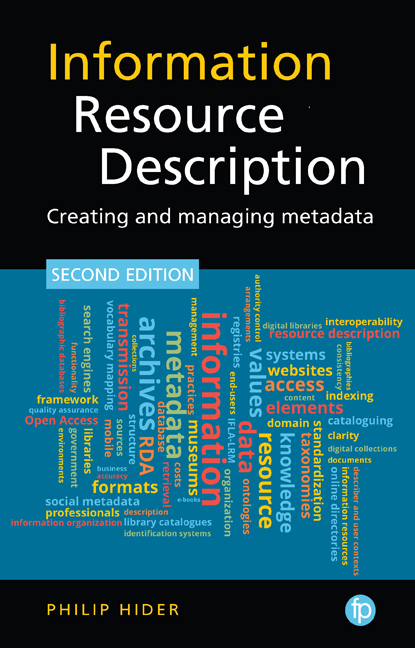Book contents
- Frontmatter
- Dedication
- Contents
- List of figures and tables
- Preface to the First Edition
- Preface to the Second Edition
- List of abbreviations
- 1 Definitions and scope
- 2 Information resource attributes
- 3 Tools and systems
- 4 Metadata sources
- 5 Metadata quality
- 6 Sharing metadata
- 7 Metadata standards
- 8 Vocabularies
- 9 The future of metadata
- Further reading
- List of metadata standards
- Index
Preface to the First Edition
Published online by Cambridge University Press: 24 September 2019
- Frontmatter
- Dedication
- Contents
- List of figures and tables
- Preface to the First Edition
- Preface to the Second Edition
- List of abbreviations
- 1 Definitions and scope
- 2 Information resource attributes
- 3 Tools and systems
- 4 Metadata sources
- 5 Metadata quality
- 6 Sharing metadata
- 7 Metadata standards
- 8 Vocabularies
- 9 The future of metadata
- Further reading
- List of metadata standards
- Index
Summary
It is said that we live in an Information Age, that we have access to volumes of information unimaginable in earlier times, and that this access has farreaching consequences for our society and economy. Most of us who have experienced the world both before and after the world wide web would surely agree that our lives have changed in all sorts of ways, due to our newfound abilities to share information – at work, at home, in our communities. As a result, it might seem as though information is all around us, as abundant as the air we breathe. We access it via our desktop, our laptop and, increas - ingly, via our smart phones, as well as by more traditional means, such as the physical library or museum.
As with air, the abundance of information does not diminish its importance. If anything, information resources have become all the more valuable, because of the integral role they play in modern life. Also like air, some information resources may be better than others. Their content may be more accurate, more relevant or more intelligible. This may not always matter so much, but sometimes finding better information can make a big difference, perhaps even a life-changing or life-saving one. The abundance of information resources in today's digital environment, however, can actually make it more difficult for people to access the information that would be of most use to them. This can be an invisible problem: people may be happy with what they find, but they might be less happy if they knew about what they had missed. It is never - theless a very real problem, and one that many information professionals spend a lot of time trying to address. Two primary ways of addressing the problem are by providing quality information resources and by organising those resources to facilitate effective access to them.
This book is concerned with the second of these activities, that is, with the organization of information resources. In particular, it is concerned with how information resources are organised through their description, providing an overview of both the process and the product (often referred to as ‘metadata’) as they function in the contemporary information environment.
- Type
- Chapter
- Information
- Information Resource DescriptionCreating and Managing Metadata, pp. xiii - xivPublisher: FacetPrint publication year: 2018



